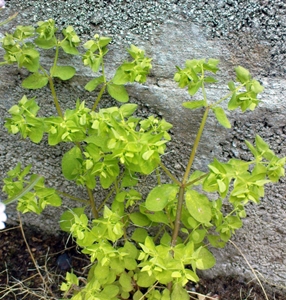Chemists at Scripps Research Institute in San Diego and Leo Pharma in Denmark devised a more efficient process to synthesize ingenol, a complex compound found in treatments for actinic keratosis, a precancerous skin condition. The team led by Scripps’s chemistry professor Phil Baran published its findings in this week’s issue of Science Express, the advance online publication of the journal Science (paid subscription required).
Ingenol mebutate, a derivative of ingenol, is the compound developed by Leo Pharma as the brand-name drug Picato, a once-daily topical gel to treat actinic keratosis, a skin condition that develops from long exposure to the sun. If left untreated, actinic keratosis can lead to squamous cell carcinoma, a serious form of skin cancer. Picato has approval from the Food and Drug Administration in the U.S., as well as regulatory authorities in Canada, Europe, and Australia.
Ingenol and its derivatives are extracted from the plant genus Euphorbia (pictured at top), whose milky sap has been a traditional treatment for skin lesions. The process for refining ingenol mebutate from Euphorbia is a difficult and time-consuming process, due to the complex chemical structure of ingenol. Previous attemps to synthesize ingenol, say the researchers, required 37 or more separate steps.
The new process for synthesizing ingenol devised by Baran and colleagues follows a two-phase approach with a total of 14 steps. The first phase starts with carene, a common and inexpensive compound found in turpentine, and generates an intermediate product, which is then refined into derivatives such as ingenol mebutate, the compound in Picato. The intermediate product, say the researchers, can be used as a more advanced starting point for synthesizing other ingenol derivatives, thus eliminating the first synthesis stage.
Baran and colleagues say the their technique produces relatively large quantities of ingenol and uses chemical processes without relying on molecular engineering. Baran notes, “there are many other complex natural compounds waiting to be synthesized using a strategy like ours,” adding, “this is really just a glimpse of the future of chemical synthesis.”
Read more:
- Renewable Biochemical Spin-Offs Land Small Business Grants
- Scripps Institute, Sigma-Aldrich to Partner on Reagents
- University Research Leads to Non-Toxic Insect Repellant
- Patent Granted for Nanotech-Enhanced Biodegradable Polymers
- Research on Insects Leads to Forestry Biochemical Start-Up
* * *


 RSS - Posts
RSS - Posts
It is definitely an excellent along with useful piece of info. I will be pleased that you distributed this beneficial facts with us. Make sure you keep us up to par in this way. Thanks for revealing.